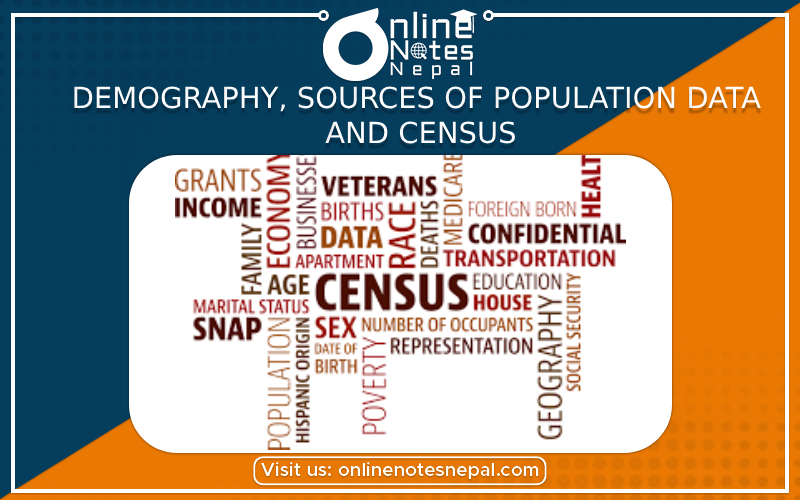Published by: Mandira
Published date: 13 Jan 2022

Demography is the science of population. It is the statistical study of population. The word 'Demography' is derived from the two Greek words 'Demos' and 'Graphy'. The word Demos means people and Graphy mean to write or to study. The word 'Demography' was first used by Achille Guillard in 1855 AD in his book "Elements of human statistics or comparative demography". He is known as the father of Demography. There are various definitions of demography given by various scholars.
The multilingual demographic dictionary has defined demography as: "Demography is the scientific study of human population, primarily with respect to its size, structure, distribution and its growth rate". Demography can be defined in two dimensions which are discussed below,
Formal Demography
It is known as mathematical demography. It is the quantitative study or mathematical study of human population. The UN multi-lingual demographic dictionary has defined formal demography as "Formal demography is the scientific study of human population primarily with respect to their size, structure and development". Similarly, according to Lucus (1987)- "Demography is a science dealing with marriage, birth, death, and migration of human population.It also involves the size, geographical distribution and composition of the population and how these changes over time".
Social Demography
Social Demography explains the issues of population studies by relating with the social and economic aspects. Social demography also studies about various subjects like Biology, Psychology, Medicine, and Geography, Environment Science and the contents of formal demography as well. So, it is also known as a multidisciplinary subject.
According to Shryock and Siegel (1976), "Social demography or population study is concerned not only with population variables eg: fertility, mortality, and migration but also with the relationship between population changes and other variables like social, economic, political, biological, genetic, geographical and the like".
Social demography deals with the relationship between population changes and other aspects like social, economic, political and geographical aspects. It is also known as population study.
We record the population of particular area living at a particular time by using various methods and sources. The sources are divided into two types, primary sources, and secondary sources. Primary sources are like the census, vital registration system whereas secondary sources are like textbooks, research reports,population monographs etc. Population data provide us information about the socioeconomic and demographic characteristics of the human population. Population data is also known as demographic data. It provides information about birth, death, migration, age, sex, marital status, nationality, religion, literacy, language, occupation, and family planning of a particular place for a particular time period. This information is important for government. This information helps the government to make plan and policies and carried out developmental activities. It also helps various non- governmental organizations to prepare plan and policies and conduct various activities.
Primary Sources
In primary sources, the data are collected directly from the field observation or households by using various data collection tools like questionnaire, observation, interview, etc. They are usually conducted by government and some non- governmental organization. Primary sources of population data are the first hand data.
The primary sources of population data are discussed below:
Census simply means the counting of people of a certain area at a certain time. It is the main source of demographic data. It is conducted by the government to know the overall population of the country. In the census, the population of the certain area is recorded based on age, sex, caste, religion etc. It is usually carried out in every 10 to 5 years. The UN (1970) has defined census as, "A population census is a total process of collecting, compiling, evaluating, analyzing and publishing demographic, economic and social data pertaining at a specified time to all persons in the country or in a well delimited territory of the country".
Methods of census
Census can be conducted by using three methods which are discussed below:
Historical Development of Census
Talking about the historical development of census, the first census was conducted in Bolivia in 4000 BC, China in 3000 BC, Egypt in 2500 BC and India in 330 to 270 BC. But these censuses were not systematic and scientific. The modern and orderly census was first started in New France and Acadia in 1665 AD. The census was then conducted regularly and orderly in USA (1790), England 91801), India (1872) etc.
In Nepal, the first census was conducted in 1911 AD. This census was not systematic and scientific. The modern type of scientific census was started in 1952/54 but it was of not international standard as it was not conducted properly. It was conducted at two different times. It was conducted in eastern Nepal in 1952 and western Nepal in 1954. The census of 1961 AD was conducted properly and was the first census of international standard. Since then, the census has been conducted in every 10 years with various improvements. The latest census of Nepal is 11th Census which was held in 2011 AD. Today, the census are conducted under the UN guideline. So, the schedule of the census is found almost similar globally.
Features of Census
Information to be collected in the Census
The Census is conducted by most of the countries of the world under the guideline of UN. It has a list of recommended and other useful topics to be covered by a census from 1970 AD onwards. This gives all the information of the individual. It is useful universally. The UN recommended census consists of following characteristics,
Geographical Characteristics
Following information are collected on this topic.
Personal and Household Characteristics
Following information are collected under this heading.
Economic Characteristics
Following information are collected on this topic.